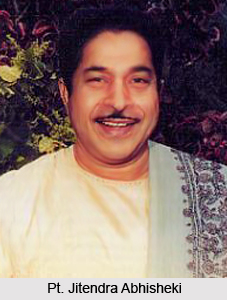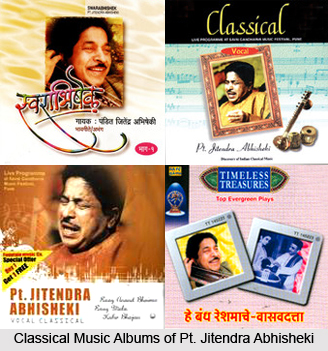 Pt. Jitendra Abhisheki belongs from a family of keertankars, and were hugely associated with temple singing. His father was an established keertan singer, and thus expected his son also to follow in his ancestral path. However, Abhisheki was an exceedingly rebellious young man and wanted to pursue in the line of Hindustani classical singing. Following a series of misunderstanding with his family, he left for Pune to find an ideal guru, from whom he could imbibe and learn the musical nuances required to be a successful singer. However, his dream was not completed so easily, and he had come face-to-face with the harsh times of the world, and was saved by generous men who took to like his singing and gave him food. However, his determination was too strong to deter him from moving away from his dream. His first step towards success came in the form of a degree in Sanskrit from Belgaum, where he had a host of prestigious and illustrious gurus to choose from, and he found his enlightened one in Pt. Jaganathbua Purohit of Agra gharana. From this point of time, he gradually became an expert in khayal renditions, to which he lent extremely individualistic thoughts and innovations. His primary significance was towards the raaga rendition, to which he infused aesthetics and shifting of moods. It looked like an ever-changing array of colours. His contribution to Marathi natyasangeet is also applaudable, due to their exceptional quality and musical experimentation.
Pt. Jitendra Abhisheki belongs from a family of keertankars, and were hugely associated with temple singing. His father was an established keertan singer, and thus expected his son also to follow in his ancestral path. However, Abhisheki was an exceedingly rebellious young man and wanted to pursue in the line of Hindustani classical singing. Following a series of misunderstanding with his family, he left for Pune to find an ideal guru, from whom he could imbibe and learn the musical nuances required to be a successful singer. However, his dream was not completed so easily, and he had come face-to-face with the harsh times of the world, and was saved by generous men who took to like his singing and gave him food. However, his determination was too strong to deter him from moving away from his dream. His first step towards success came in the form of a degree in Sanskrit from Belgaum, where he had a host of prestigious and illustrious gurus to choose from, and he found his enlightened one in Pt. Jaganathbua Purohit of Agra gharana. From this point of time, he gradually became an expert in khayal renditions, to which he lent extremely individualistic thoughts and innovations. His primary significance was towards the raaga rendition, to which he infused aesthetics and shifting of moods. It looked like an ever-changing array of colours. His contribution to Marathi natyasangeet is also applaudable, due to their exceptional quality and musical experimentation.
Jitendra Abhisheki`s origins go back to Goa. He was born in 1933 into a family in the village of Mangesh. Generations of his family were associated with the famous Shiva temple in Mangesh. Great women singers like Kesarbai Kerkar and Mogubai Kurdikar were also associated with this temple during their early singing years. Abhisheki`s father, Balwantrao Abhisheki, was a reputed keertankar and knowledgeable in classical music, especially dhrupad. Abhisheki picked up his first lessons here. His father nurtured fond hopes that his son would follow his footsteps as a keertankar and continue his legacy. But the youngster had other dreams - he wanted to become a classical singer. Owing to serious differences of opinion with his father on this subject, he was compelled to leave home in search of a guru of his dreams to Pune, the Kashi of music is Western India. As might have been expected, the stubborn father cut off the equally stubborn son following this parting of ways.
For a while, Pt. Jitendra Abhisheki received training under Naharbua Purohit and Yashwantbua Marathe in Pune. But life in Pune was difficult for the teenaged Abhisheki, as he had neither the resources nor his family`s support to get on with his quest. He stoically subsisted on madhukari, or the charity of the public, during this time. He was saved many a time from the brink of starvation by generous-minded lovers of music in Pune who divined promise in this unwavering youngster. He also had to endure much contempt, humiliation and ridicule during his years of training. But his resolve was way too firm to admit defeat. In a sense, Abhisheki`s early year of quest could be compared to Bhimsen Joshi`s search through various parts of north India for the ideal teacher. Though less event-filled, the intense desire for perfection, and the agonies suffered for the same, was no less remarkable. It is sad fact that none, save the music critic Mohan Nadkarni, has brought aspects of Abhisheki`s early years to light.
 He moved to Belgaum to take a degree in Sanskrit. While working for his degree, he came down with typhoid, which nearly wrecked his voice. Those who heard him sing after his recovery remarked that his career was over. Abhisheki determinedly undertook rigorous practice sessions to regain the voice he had lost. What emerged was a voice possessing strength and solidity, and tempered in the searing fires of privation, agony and tenacity. After taking his degree in Sanskrit, Abhisheki worked for a while with AIR Bombay. His quest for perfection brought him to the presence of some of the finest gurus in Western India - Ustad Azmat Hussain Khan of Agra gharana, Gulubai Jasdanwale, a direct student of Usatd Alladiya Khan, Ustad Azizuddin Khan of Jaipur-Atrauli gharana and, most importantly, the renowned Pt. Jaganathbua Purohit of Agra. In Jaganathbua, he found a guru who possessed all the virtues he was searching for until that time. By this time, Abhisheki was striding confidently into the concert arena.
He moved to Belgaum to take a degree in Sanskrit. While working for his degree, he came down with typhoid, which nearly wrecked his voice. Those who heard him sing after his recovery remarked that his career was over. Abhisheki determinedly undertook rigorous practice sessions to regain the voice he had lost. What emerged was a voice possessing strength and solidity, and tempered in the searing fires of privation, agony and tenacity. After taking his degree in Sanskrit, Abhisheki worked for a while with AIR Bombay. His quest for perfection brought him to the presence of some of the finest gurus in Western India - Ustad Azmat Hussain Khan of Agra gharana, Gulubai Jasdanwale, a direct student of Usatd Alladiya Khan, Ustad Azizuddin Khan of Jaipur-Atrauli gharana and, most importantly, the renowned Pt. Jaganathbua Purohit of Agra. In Jaganathbua, he found a guru who possessed all the virtues he was searching for until that time. By this time, Abhisheki was striding confidently into the concert arena.
Alongside khayal, Abhisheki also made significant forays into Marathi natyasangeet and light music, and made an indelible impact in these fields. He was one of the key figures responsible for the revival of poetic drama. His musical scores and stage-songs are deeply etched in the memories of Marathi theatre-goers. While not diluting classical principles, Abhisheki went on to discover the emotional bases of popular music and infused the solidity of classicism to reinforce it. The songs in the play Yayati-Devayani of the 1960s are sung and glorified even today. The high classicist in him worked jointly with the experimentalist. His contributions to this field continued until very late in his life.
While it is important to keep in mind the impact of all the styles he absorbed, the one thing that becomes evident is that Abhisheki`s approach to the khayal is highly individualistic. In his case, creative eclecticism existed alongside an acute musical intelligence that keenly absorbed what suited him. Aesthetics and mood were of primary importance to him when presenting raagas. He always compared a raaga to a piece of canvas, the swaras to colours, and the musician to the portrait painter, who imaginatively and judiciously used the right kinds of colours to suit the subject. Unlike several other khayal singers, Abhisheki had a penchant for vocalising the words of the bandish emphatically and evocatively. His early training as a keertankar and his Sanskrit studies helped in this regard. The ambience of dhvani, or the subtle reverberations of the word which work at the subliminal level, fascinated him endlessly. Listeners can feel these reverberations of words in his husky hum.
Though not widely recorded, many of Abhisheki`s albums maintain a high aesthetic standard. His Marwa and Bilaskhani Todi, both challenging raagas, that came out in the 1960s show immense maturity and brilliance. One always thought that it is difficult for any singer to create a lasting impact with Marwa, especially after Amir Khan`s hypnotic rendition. Also, Marwa`s mood is extremely difficult to capture. But Abhisheki`s rendition of a Tansen composition would have one thinking about the deep emotional atmosphere of this sombre raaga. Abhiskeki`s Marwa has a powerful note of appeal, a poignant prayerful note, especially the way he enunciates the opening line He ishwar mohiyake jaanath. The memorable transition to the antara Tu hi aadi tu hi anth is very affecting. Similarly, his Bilaskhani Todi is a fine sample of his deeply pondered art. His Madhuvanti, Darbari, Nayaki Kanada, Din-ki-Poorya and Gavati reveal his individualistic approach to raagas, especially his keen desire to discover the off-beat in the beaten path. Poised expressivity, clarity of raaga development and innovative modes of raaga phrasing are some of the notable aspects of these recordings. The music lover and the connoisseur will discover new intricacies and beauties in many of the lengthy live recordings that came out posthumously.
By any standards, however, his live rendition of the Carnatic raaga, Amritvarshini, brought out by Virgin Records, is a marvel and a milestone in Abhisheki`s musical career. This raaga, associated with the monsoons in the Karnatic tradition, becomes the basis for a 50-minute performance by a true master. Contemporary Karnatic musicians tend to treat this raaga rather fleetingly. Abhisheki`s Amritvarshini must rank with the great renditions of Karnatic raagas by Hindustani maestros - Amir Khan`s Abhogi and Charukeshi, Ravi Shankar`s Simhendra Madhyamam or Shiv Kumar Sharma`s Kirwani. No contemporary Hindustani musician has paid a greater tribute to one of the great composers of the South in so fitting a manner - made all the more interesting by the fact that Dikshitar was the first major Carnatic composer to be influenced by several aspects of Hindustani music.
Abhisheki`s last years in Pune were not happy ones, given his prolonged illness and his growing feeling that the culture of singing, instruction and listening were changing in uncongenial ways. In an attempt to address these problems, he started a gurukula in Lonavala to impart musical instruction to students free of charge, thus embracing the deepest principle of Indian culture that the gifting of knowledge (vidyadaan) is the highest offering and service. The long-term impact of this institution will only be felt in the future. Importantly, he trained a handful of students who are major to notable presences in the concert circuit. Prabhakar Karekar comes first in the list of students he trained who carved a niche for himself by virtue of his many musical gifts. Asha Kadilkar, Shivanand Patil, Hemant Pendse, Ajit Khadkhade and Raja Kale are some of his other well-known students. His son Shaunak is also making a name for himself. Abhisheki died in 1998 following prolonged bouts of illness.




